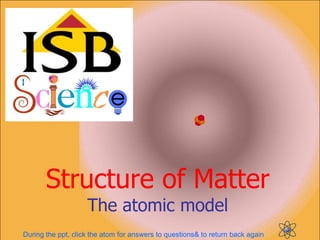Basic Atomic Structure
•Descargar como PPTX, PDF•
5 recomendaciones•8,050 vistas
Denunciar
Compartir
Denunciar
Compartir

Recomendados
Más contenido relacionado
La actualidad más candente
La actualidad más candente (20)
Class 11 chapter 3 Cassification of elements and periodicity in properties ppt

Class 11 chapter 3 Cassification of elements and periodicity in properties ppt
Properties and Formation of Ionic Compounds Powerpoint

Properties and Formation of Ionic Compounds Powerpoint
Destacado
Destacado (20)
Standard Model in Particle Physics, Physical Science Lesson PowerPoint

Standard Model in Particle Physics, Physical Science Lesson PowerPoint
Similar a Basic Atomic Structure
Similar a Basic Atomic Structure (20)
Más de David Young
Más de David Young (20)
2011 topic 01 lecture 3 - limiting reactant and percent yield

2011 topic 01 lecture 3 - limiting reactant and percent yield
Último
Último (20)
CNIC Information System with Pakdata Cf In Pakistan

CNIC Information System with Pakdata Cf In Pakistan
Apidays New York 2024 - The value of a flexible API Management solution for O...

Apidays New York 2024 - The value of a flexible API Management solution for O...
Biography Of Angeliki Cooney | Senior Vice President Life Sciences | Albany, ...

Biography Of Angeliki Cooney | Senior Vice President Life Sciences | Albany, ...
Apidays New York 2024 - Scaling API-first by Ian Reasor and Radu Cotescu, Adobe

Apidays New York 2024 - Scaling API-first by Ian Reasor and Radu Cotescu, Adobe
EMPOWERMENT TECHNOLOGY GRADE 11 QUARTER 2 REVIEWER

EMPOWERMENT TECHNOLOGY GRADE 11 QUARTER 2 REVIEWER
"I see eyes in my soup": How Delivery Hero implemented the safety system for ...

"I see eyes in my soup": How Delivery Hero implemented the safety system for ...
Polkadot JAM Slides - Token2049 - By Dr. Gavin Wood

Polkadot JAM Slides - Token2049 - By Dr. Gavin Wood
Boost Fertility New Invention Ups Success Rates.pdf

Boost Fertility New Invention Ups Success Rates.pdf
Apidays New York 2024 - APIs in 2030: The Risk of Technological Sleepwalk by ...

Apidays New York 2024 - APIs in 2030: The Risk of Technological Sleepwalk by ...
TrustArc Webinar - Unlock the Power of AI-Driven Data Discovery

TrustArc Webinar - Unlock the Power of AI-Driven Data Discovery
Connector Corner: Accelerate revenue generation using UiPath API-centric busi...

Connector Corner: Accelerate revenue generation using UiPath API-centric busi...
DEV meet-up UiPath Document Understanding May 7 2024 Amsterdam

DEV meet-up UiPath Document Understanding May 7 2024 Amsterdam
WSO2's API Vision: Unifying Control, Empowering Developers

WSO2's API Vision: Unifying Control, Empowering Developers
Rising Above_ Dubai Floods and the Fortitude of Dubai International Airport.pdf

Rising Above_ Dubai Floods and the Fortitude of Dubai International Airport.pdf
AWS Community Day CPH - Three problems of Terraform

AWS Community Day CPH - Three problems of Terraform
Finding Java's Hidden Performance Traps @ DevoxxUK 2024

Finding Java's Hidden Performance Traps @ DevoxxUK 2024
Apidays New York 2024 - The Good, the Bad and the Governed by David O'Neill, ...

Apidays New York 2024 - The Good, the Bad and the Governed by David O'Neill, ...
Basic Atomic Structure
- 1. Structure of Matter The atomic model During the ppt, click the atom for answers to questions& to return back again
- 2. Brainstorm . . . What do we know about the structure of an atom?
- 3. Brainstorm . . . What do we know about the structure of an atom? comprised of protons, neutrons and electrons protons are positively charged electrons are negatively charged very small mostly empty space protons and neutrons form nucleus electrons found in space surrounding the nucleus
- 4. Inside an Atom Electric Relative Position in charge mass (to atom each other) Lithium atom
- 5. Inside an Atom Electric Relative Position in charge mass (to atom each other) proton +1 1 nucleus Lithium atom neutron 0 1 nucleus Energy 1 levels electron –1 1840 around nucleus
- 6. Atom Models in History The last 200 years have seen ideas about the atom develop from Dalton’s “indivisible atom” where it is the smallest thing possible; to the discovery of sub-atomic particles (electrons, protons & neutrons); to sophisticated understandings about where these particles are found and how they behave. Each model has allowed hypothesises to be made & predictions tested. This has lead to the development of our knowledge as the technology has improved. video link
- 7. Relative Sizes in an Atom atoms are really small! The space electrons occupy is most of the space in an atom. (if the atom was 1 km across, the nucleus would be 1 cm across)
- 8. The scanning tunnelling microscope (a recent invention) lets us “see” atoms for the first time. Nickel atoms – showing the regular arrangement of “particles” in a solid Note: the colours are artificially added by computer – nickel atoms aren’t blue!
- 9. Review of Building Atoms Exercise
- 10. Atomic Number Lithium atom Atoms from different elements differ in their number of protons. Atomic Number = number of protons In a neutral atom, number of protons = number of electrons
- 11. Mass Number Mass number = number of protons + neutrons Number of neutrons = Mass number – Atomic number In this Helium Atom: 4 Atomic number = 2 Mass number = 4 2 He number of protons = 2 Helium atom number of electrons = 2 number of neutrons = (4 – 2) = 2
- 12. Ions Ions are atoms that have lost or gained electrons. Ions have an electrical charge: losing electrons makes positive ions (more protons than electrons) gaining electrons makes negative ions (more electrons than protons) Ex Chlorine atoms gain 1 electron → Chloride ions Cl–1 Ex Sodium atoms lose 1 electron → Sodium ions Na+1 Ex Oxygen atoms gain 2 electrons → Oxide ions O–2 Ex Magnesium atoms gain 2 electrons → Magnesium ions Mg+2
